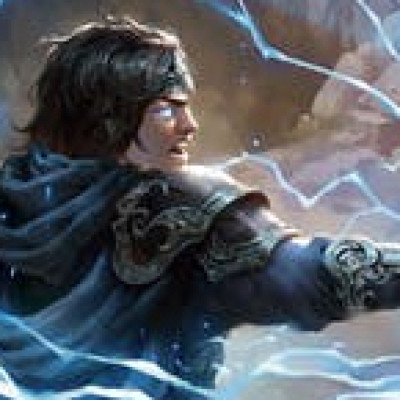The Illusionist class has been a hot topic ever since it was first teased in the Welcome to Rathe lore book. A practitioner of the arcane arts, sculptor of visions, and master of reality, the idea of it immediately caught the attention of theory-crafters and custom card creators alike. Fan-made iterations ranged from face-down cards, attaching a ‘real’ card beneath an illusion, swapping cards between the field and the hand, bluffing your heart out between illusion and reality...
But all of them fell into the same trap: how can you make a class whose entire identity relies on the manipulation of reality without the use of hidden information becoming toxic?
In hindsight, the answer seems simple:
Flavour
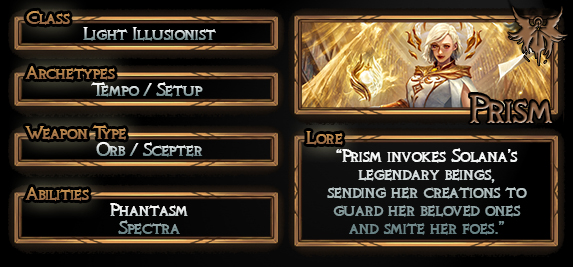
The Illusionist Philosophy
I have to commend Legend Story Studios on the thought they put into the design of Prism and the Illusionist class, centering their entire design around one core philosophy: an illusion is only real if you let it be. From this, they built the Phantasm mechanic: an intensely powerful attack is only real if left unchallenged, but if an attack of 6 or more power is used to defend, then the illusion is revealed and dispersed.
Similarly, cards with Spectra change the dynamic of the battlefield, but disappear when attacked- sapping the opponent’s action point and leaving them stumbling and vulnerable. Prism, the Light Illusionist, is built on this philosophy. She weaves stories and parables that she learned in the Great Library of Solana into semi-tangible mosaics of light, and dominates the battlefield with blazing conjurations of the Heralds.
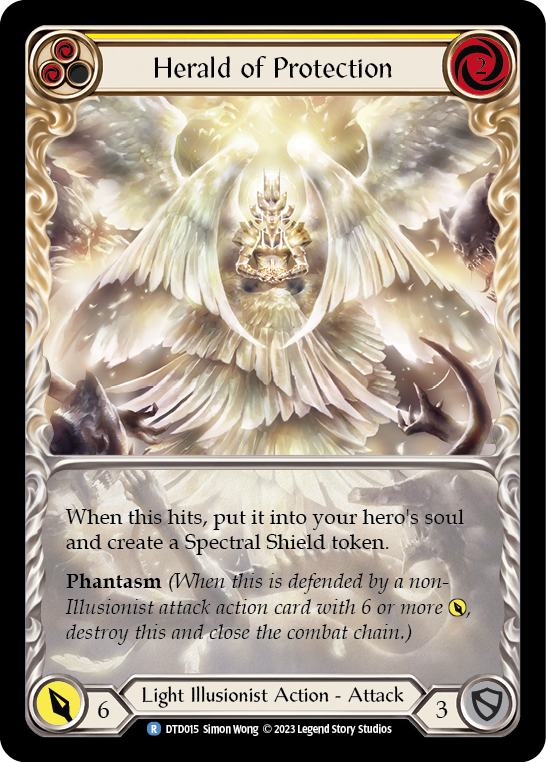
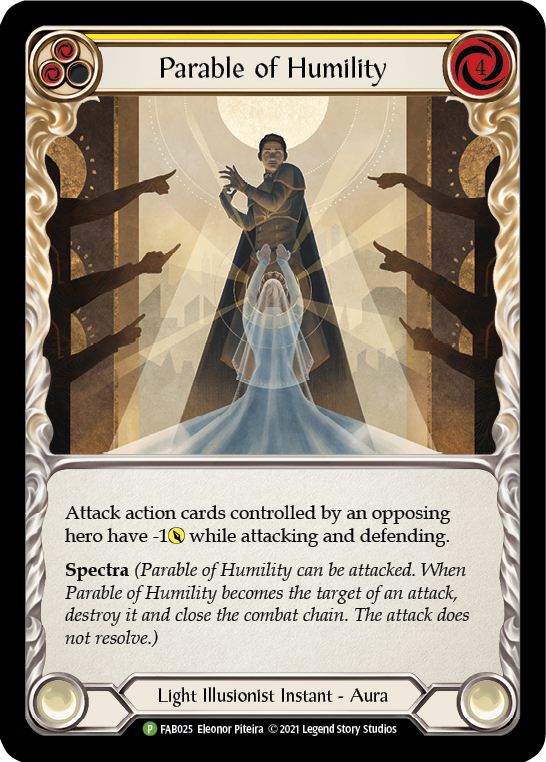
The final piece in the puzzle: the weapon, lenses that grant all of your auras a fragment of reality to attack your opponent from all sides. The Iris of Reality turns all of your auras into weapons that attack for 4 with go again, creating a powerful mid-game presence. Luminaris, the signature weapon of Prism, gives all Illusionist attacks go again from a yellow pitch, enabling enormous turns with multiple heralds.
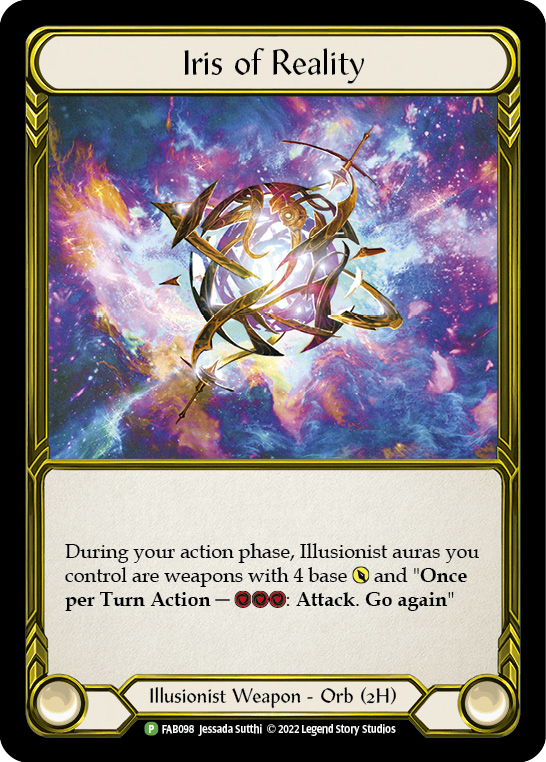
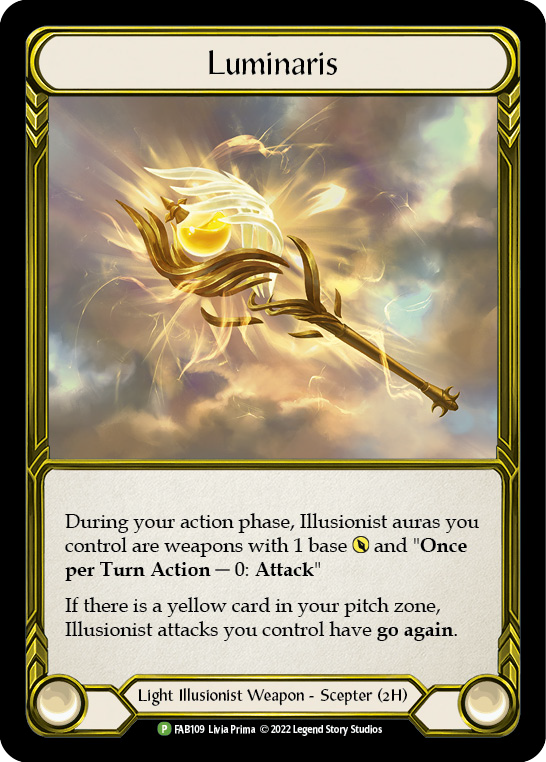
Prism, Sculptor of Arc Light
As one of two heroes of the Light talent as of the release of Monarch, Prism has access to her soul, a cache of cards attached to her hero card that can be used in a variety of different ways, including via her hero ability.
Once per turn Instant – 2(r), banish a card from Prism’s soul: Create a Spectral Shield token.
Spectral shield tokens are auras that prevent 1 damage of any type before destroying themselves. They can be extremely useful, as they still count as auras for your weapon! They can be used both defensively and offensively, and are a core part of the game plan for Illusionists.
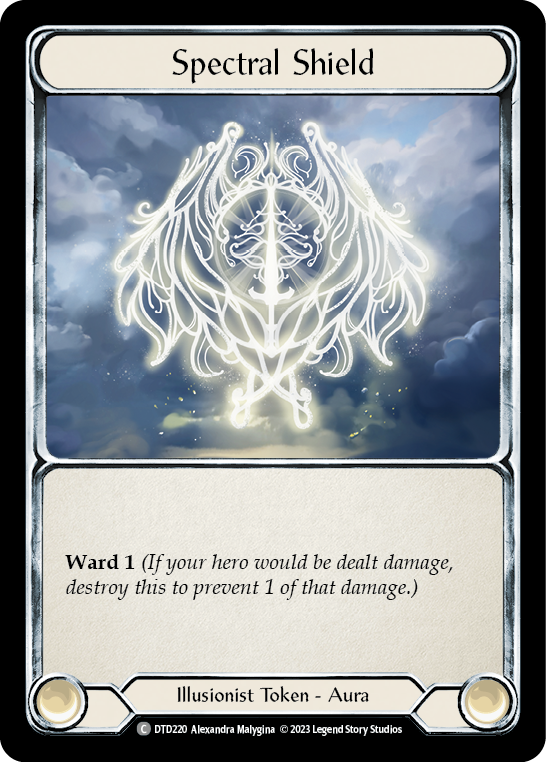
Your soul can also interact with your equipment and cards, such as Halo of Illumination allowing you to set a card in your soul and draw up again to refresh your resources, Vestige of Sol giving you bonus resources every time you pitch a light card, and Celestial Cataclysm using your soul as an alternate resource!
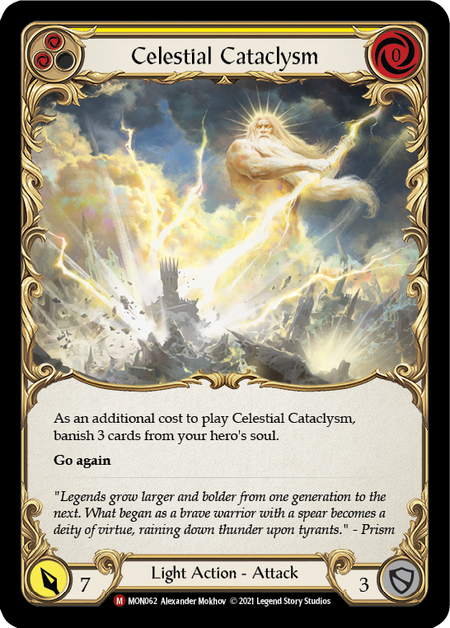

Pro Tip: Prism’s hero ability is an Instant, meaning you can also use it on your opponent’s turn to block a nasty on-hit threat, or to bank an additional shield to attack with!
Building Prism
The design of Illusionist draws a player in one of two directions. The first, a dominating glory on the battlefield, summoning incarnations of the Heralds to blind and assault opponents with never-before seen power. The second, a pacifist protector, conjuring a suite of auras to both protect yourself and dance around your opponent, leaving them confused and disoriented as you whittle down both their resolve and their life total. (After exploring these two paths, I'll also show you a hybrid approach, which I personally favor.)
Glory of the Heralds
Pros:
- Extremely high damage output.
- Consistent.
- Dominates any deck that doesn't run 6+ power cards.
Cons:
- Struggles vs. decks that run many 6+ power cards.
- Very weak from 1-card hands.
- Lost tempo means lost game.
Aggro Herald Prism is a dominant force on the battlefield, with some of the highest average damage output of any deck in the game. This strategy maximizes free action economy from Luminaris and the nasty 7-damage-for-2-resource economy of most Heralds. The average turn can threaten 14 damage across 2 attacks with on-hit effects! However, if an opponent has the strength to challenge your illusions with 6+ power defending cards, you’re a sitting duck.
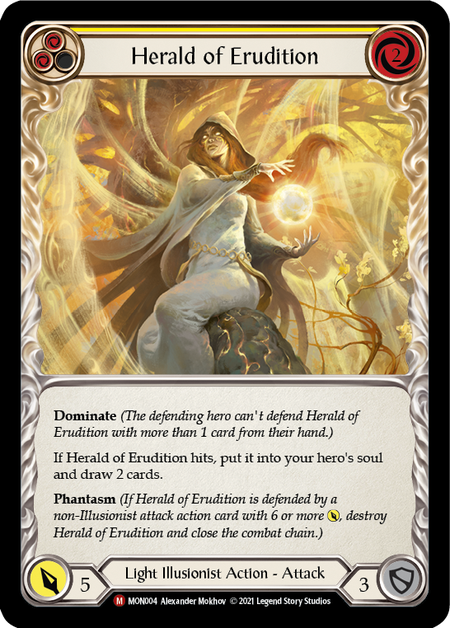
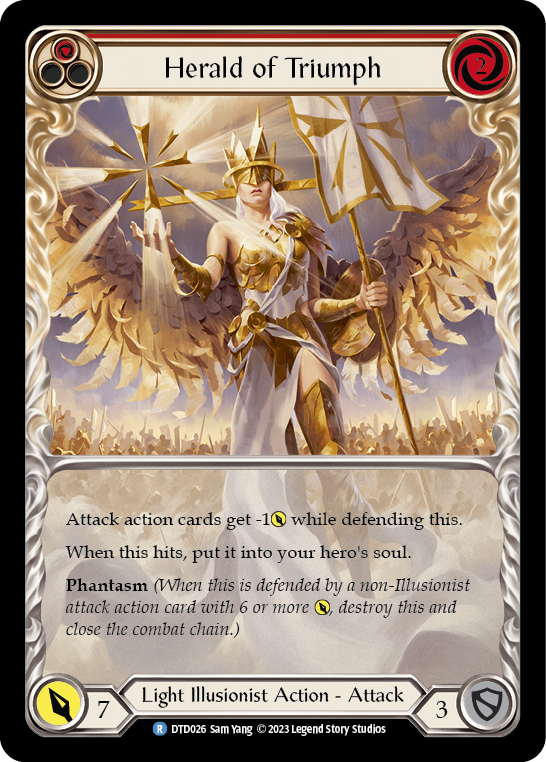
Heralds put themselves into Prism’s soul whenever they hit; and with that nasty 7 damage breakpoint, they do so very frequently. You can then use that soul to build up shields that can attack for 1 with Luminaris, or go all-out with a Celestial Cataclysm for a free 7 damage with go again. Either way, with this aggro playstyle, you’ll be having incredibly strong turns with frightening frequency.
If you’re interested in playing like this, try out this herald deck from our Prism expert, Conor Grant.
Spectacular Spectras
Pros:
- Very strong defense & disruption.
- Powerful late-game board states.
- Can often come back to win from behind.
Cons:
- Poor matchups against wide decks.
- No recursion- an aura, once lost, is gone forever.
- Can draw into hands with limited or no ability to block.
Aura Control Prism is a completely different- but equally viable- style of play. This deck aims to use Prism’s surprisingly potent defensive ability to preserve your life total while playing out auras that can massively influence your side of the board. Thanks to Luminaris, each of your auras- including your Spectral Shields- turns into a weapon that deals 1 damage for free; so with a yellow in your pitch zone and a whole field of auras, you can chip away at your opponent’s life total while defending your own with ease. Once your opponent’s life is low enough, they’ll have to start spending whole cards to block single points of damage!
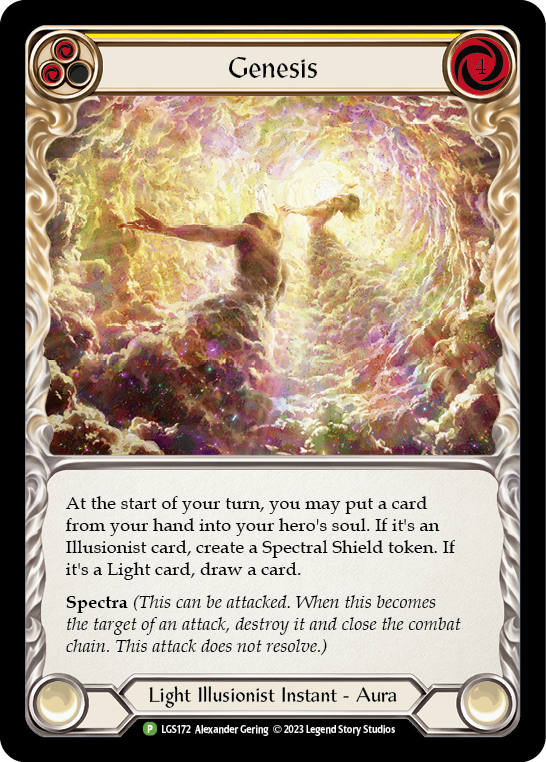
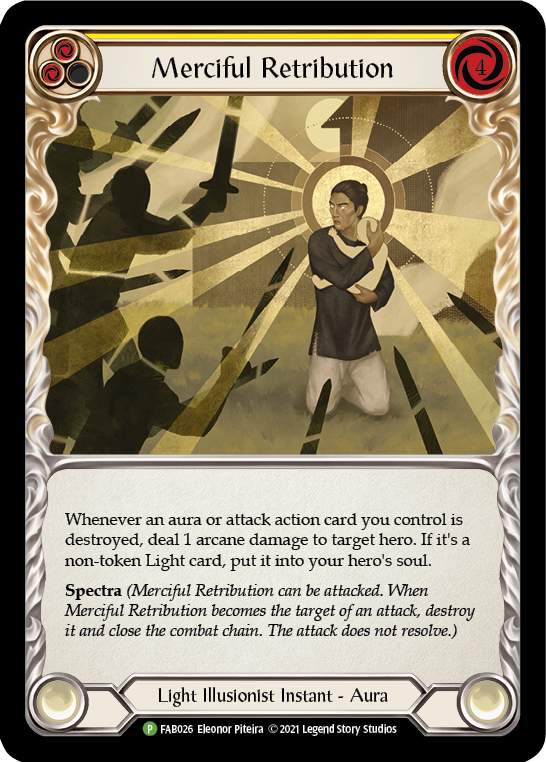
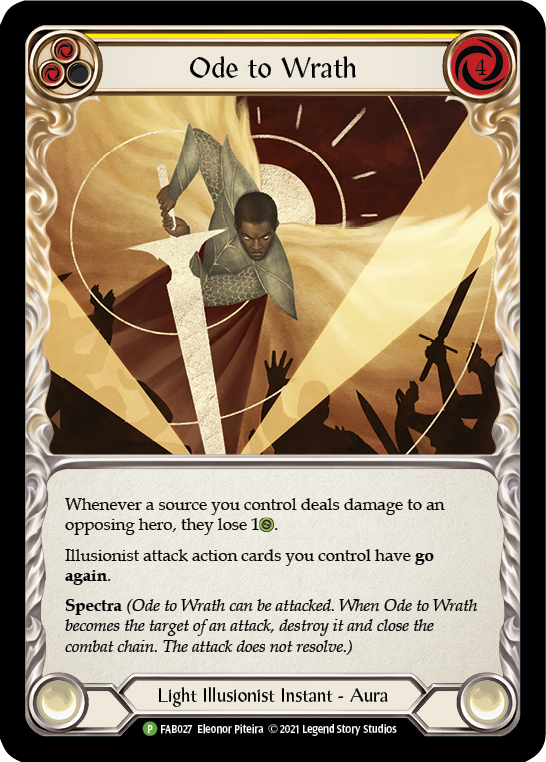
With Ode to Wrath on the field, your opponent loses life with each attack they don’t block. Genesis gives you passive shields and a steady flow of cards into your soul. Merciful Retribution deals damage to your opponent when they even try to scratch at your wall of Spectral Shields. In the endgame, with a full set of auras, you can block with 3 cards from hand and still pitch a yellow to your hero ability, enabling all your auras to swing back for one damage at a time.
Be careful in the early game, however, as your auras are not able to block and can leave you defenseless if you draw multiple in the same hand.
If you like the sound of building yourself into a practically invulnerable powerhouse, try out this list (also from Conor Grant). You can also aim for a more control/combo version of this deck using Iris of Reality; I'll let Conor explain that one.
The Midrange Monster
Pros:
- Can win almost any matchup.
- Uses the sideboard to switch focus at the outset.
- Can pivot mid-game to a different playstyle.
Cons:
- Weaker aggression than Heralds, weaker defenses than Spectra.
- Can struggle with damage output against a few decks that happen to be meta favorites.
If you’re like me and hate committing to one path, this deck is for you. Taking the skeleton of the Herald aggressive build and supplementing it with a generous package of Spectras allows this deck to be astonishingly versatile. The way it plays into a Guardian will be entirely unrecognizable from the way it plays into a Ninja, and that decision is made as early as the sideboard phase.

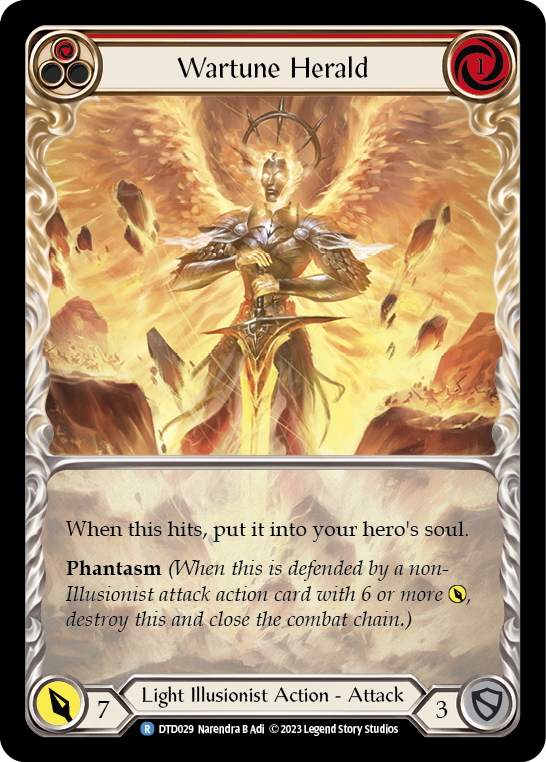
With such a vast toolbox at its disposal, this deck can win any matchup with enough forethought. Its ability ranges from a dominant aggressive deck in tempo-focused matchups to an oppressive control deck that can outlast even the greatest tanks of the meta. The trade-off for its versatility, however, is a lack of specialization, and either of its playstyles are individually less powerful than their specialist counterparts. If you like the sound of a deck that always has the counter for your opponent, you can't do any better than starting with- you guessed it- a list from Conor Grant.
To the Battlefield!
Now that you’ve got the idea of the basics and playstyle, and have a wealth of options for what direction you want to take your Prism journey, take these decks to your local Armory events and fiddle with them until you find something that works for you! And don’t be afraid to experiment with weird combos and cards. Good luck!


